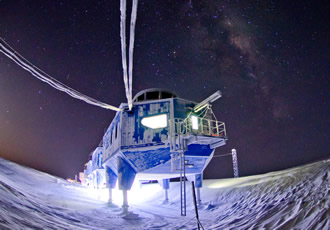ECS continues support for British Antarctic Survey station

The British Antarctic Survey (BAS) has been undertaking scientific research on and around the Antarctic continent for over 60 years. The extremes of weather mean that the various structures used to house equipment, laboratories, workshops and accommodation are continuously being improved and replaced. ECS Engineering Services has been supporting this work by supplying high specification, bespoke steel fabrications each year for the last 20 years.
Structures destined for the Antarctic must be designed to withstand prevailing winds of up to 90 miles per hour and an average external temperature of –30ºC with an extreme minimum of -56ºC. The most recent addition to the landscape is the iconic Halley VI Research Station that is the first fully re-locatable research station in the world.
There is a constant battle to overcome approximately 1.2 m of snow that accumulates each year on the Brunt Ice Shelf, covering and eventually crushing buildings on the surface. To make matters worse, this part of the ice shelf is also moving westward by approximately 700m per year.
The first four research stations have been buried and crushed but Halley V was the first station to use a combination of jacks and stilts to raise the station each year to overcome the accumulation of snow. However, as the station’s legs were fixed in the ice it could not be moved and its occupation became precarious, having flowed too far from the mainland to a position at risk of breaking away like an iceberg.
Over the years, ECS has provided a considerable amount of steelwork for the Halley V station and that has led to further work related to the establishment of Halley VI.
Rob Butts, Production Manager at ECS, comments: "We have a long-standing relationship with BAS and we have delivered an increasing amount of work year on year. We use S355K2 grade materials that are impact tested in order to achieve the client’s requirements and create the various designs which are then galvanised to 140 microns and in some cases painted as well."
ECS has a long history of working with BAS going back 20 years which has seen them deliver fabricated steelwork, designed and constructed to withstand the very harsh conditions. The more recent construction of Halley VI has included a number of research cabooses, which look like large yellow shipping containers on stilts, and the Turbulence Tower.
BAS provide initial design drawings to ECS where they are turned into fabrication drawings and, following approval, fabrication gets under way in order to meet the shipping date. While the majority of the work is classed as EXC3 under CE certification guidelines, ECS also provides some structures to EXC2 which requires a lower level of quality control and traceability.
This year's work has included 25 lengths of triangular trusses that will make up part of the Halley Tower and a number of leg extensions for the cabooses as well as hinged staircases that can move with the changing snow levels. In addition, ECS will manufacture a number of tower raising frames each year for BAS over the next 4 years.
In total ECS was contracted to deliver nearly 25 tonnes of fabricated steelwork this year, all of which had to be delivered to the UK port in time for the appointed sailing of the vessel to The Falkland Islands, a date that could not be missed.
Similar articles
More from ECS Engineering Services Ltd
- ECS resolves a Rye old issue in south coast tidal surge defences 7th October 2020
- Electro-mechanical solution plays key role at pumping station 14th November 2017
- Pumping station renovation improves flood defences 29th August 2017
- Sluice gates to receive a new paint job 7th August 2017












Write a comment
No comments